{english below} “Chernobyl” (Gost Books 2024 – more info) de Pierpaolo Mittica es una obra fotográfica que documenta las consecuencias del desastre nuclear de Chernobyl, ocurrido en 1986 en Ucrania, entonces parte de la Unión Soviética. Mittica, fotógrafo y documentalista italiano, es conocido por su trabajo que explora temas de justicia social y medioambiental, y en este libro, se adentra profundamente en el legado de uno de los desastres nucleares más graves de la historia. A lo largo de su trabajo en “Chernobyl” se tratan diferentes aspectos: la destrucción del medio ambiente y los efectos duraderos de la radiación en la naturaleza y en la salud humana o la resiliencia de las personas que, a pesar de los riesgos, continúan viviendo en estas áreas afectadas, mostrando cómo la vida persiste en medio de la desolación.
El trabajo de Pierpaolo Mittica ha sido aclamado por su capacidad para documentar no sólo la devastación, sino también la dignidad de las personas afectadas por Chernobyl. Sus fotografías son testimonio de las consecuencias a largo plazo de los desastres nucleares y una advertencia sobre los peligros que aún acechan en lugares como Chernobyl.
Además de su fotografía, Mittica también ha realizado cortometrajes documentales y es un activista comprometido con la causa ambiental y humanitaria. Despues de conocer y empaparnos de su nueva obra, teníamos claro que queríamos lanzarle unas preguntas y conocer mas de Pierpaolo. Here we go!
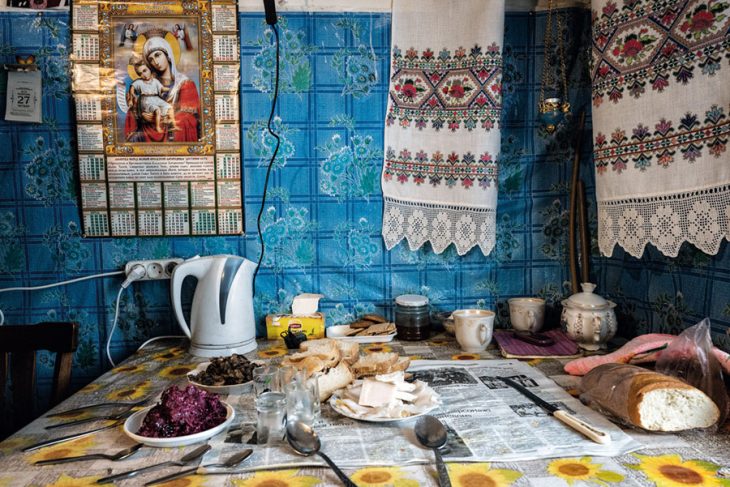
The table ready for lunch in the house of Hanna Zavorotnya. Kupovate, Chernobyl exclusion zone, 2016 © Pierpaolo Mittica
Tu trabajo sobre Chernóbil va más allá de la fotografía, abarcando una profunda denuncia social y medioambiental. ¿Cómo lograste equilibrar la necesidad de documentar la tragedia humana y el entorno devastado sin explotar el sufrimiento?
Para mí, la fotografía siempre ha sido un medio para contar historias, historias de personas que sufren y soportan inmensas injusticias. Pero también historias de gran humanidad y resiliencia, y de cómo las personas sobreviven en entornos devastados por la contaminación.
Siempre he creído que la fotografía, más que mostrar, debe hacer pensar. Nunca me han gustado las fotografías que “gritan”, las que muestran “demasiado”. Al contrario, creo que una parte no debe mostrarse directamente, sino dejarse a la imaginación del espectador. Una parte debe ser narración y otra parte poesía. Solo así las fotografías pueden impactar la imaginación del espectador y conmoverlo emocionalmente. También creo que es esencial mostrar siempre respeto por el sujeto fotografiado, y esto solo puede lograrse a través de la delicadeza, la poesía y el respeto. Para mí es un proceso natural porque forma parte de mi carácter y mi forma de ser.
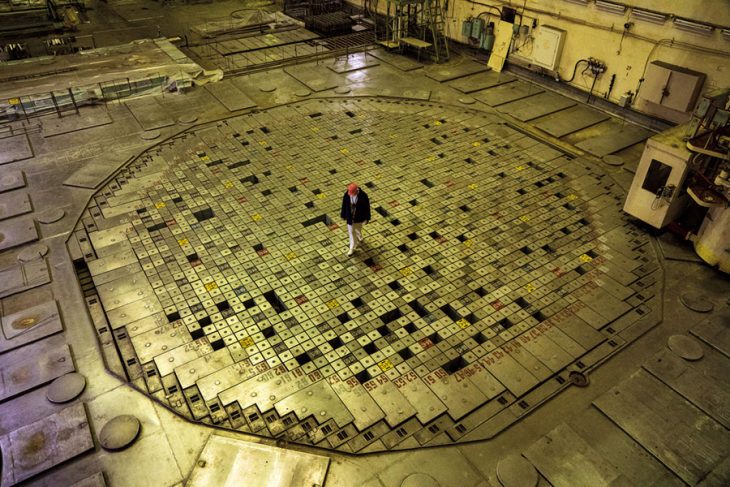
The rods to control the nuclear reaction, on the top of reactor number 3. Chernobyl nuclear power plant, Chernobyl Exclusion Zone, 2019 © Pierpaolo Mittica
Al capturar la vida en la zona de exclusión de Chernóbil, ¿cómo afrontaste el reto de transmitir no solo el horror de la catástrofe, sino también la resiliencia y humanidad de quienes continúan viviendo en esas áreas?
Cuando comencé a documentar Chernóbil en 2002, mi primer proyecto fue contar la historia de las consecuencias sanitarias y medioambientales de esta enorme catástrofe. Durante todos estos años documentando y estando en la zona de exclusión, descubrí un mundo increíble, una zona de exclusión que no estaba muerta, sino muy viva, formada por personas que seguían viviendo y trabajando dentro de ella. Un mundo de resiliencia y amor por esa tierra perdida para siempre. Esto me fascinó profundamente: cómo los seres humanos logran superar terribles condiciones de vida, ya sea por necesidad, por deber o simplemente por amor.
En 2014 comencé la segunda parte de mi proyecto sobre Chernóbil, que terminé en 2019 y fue publicado por Gost Books, para contar estas historias simples pero al mismo tiempo extremadamente complejas de vida. Por ejemplo, los reubicados, los ancianos que querían volver a vivir en sus casas dentro de la zona de exclusión porque el amor por esa tierra era demasiado fuerte. Además, historias muy especiales que tuve la suerte de documentar primero, como la de los “Stalkers” de Chernóbyl, jóvenes ucranianos que ingresan ilegalmente a la zona de exclusión para emprender un increíble viaje a la ciudad fantasma de Prípiat, o la historia de los judíos jasídicos. Antes del accidente, Chernóbil tenía una historia importante como cuna del jasidismo, una de las corrientes más importantes de la religión judía, y cada año los jasídicos peregrinan a las tumbas del fundador de su religión, situadas en la ciudad de Chernóbil. Todo esto lo descubrí gracias a mi guía de confianza, Yuriy Tatarchuk, quien en todos estos años de amistad y trabajo conjunto me introdujo a estas historias.
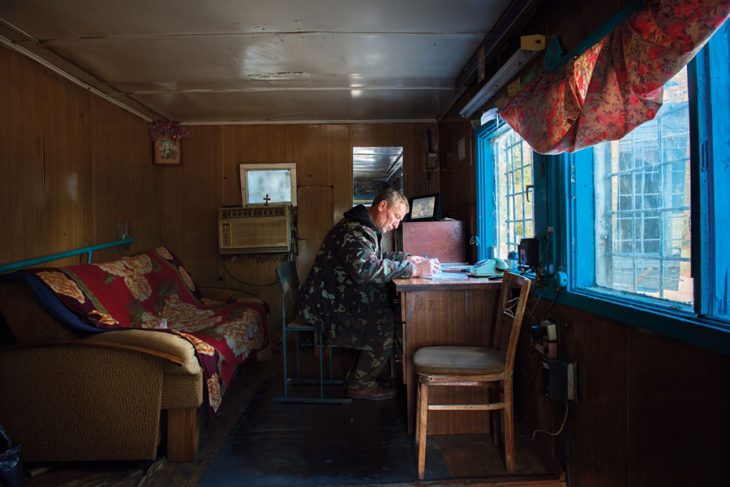
The hall of the ‘hotel Pripyat’ for tourists. Chernobyl City, Chernobyl exclusion zone, 2017 © Pierpaolo Mittica
El desastre de Chernóbil está profundamente asociado con imágenes icónicas de abandono y desolación. ¿Cómo abordaste la creación de una narrativa visual que ofreciera una perspectiva nueva sobre un tema tan ampliamente cubierto?
Cuando comencé a documentar Chernóbil en 2002, pocos fotógrafos occidentales habían abordado Chernóbil. En ese momento, probablemente solo Paul Fusco, Gerd Ludwig y algunos otros lo habían hecho. Era un mundo por contar y eso me fascinaba. En los últimos años, con la apertura de la zona de exclusión al turismo en 2011, ha habido un aumento masivo de imágenes de la zona, especialmente de lugares abandonados que se han convertido en atracciones turísticas, como la ciudad fantasma de Prípiat.
Para mí, los lugares abandonados siempre han representado sitios donde antes había vida, y debido al accidente, esa vida fue borrada. En mis fotos de lugares abandonados siempre he intentado evocar la vida que estuvo allí antes, a través de fotografías simbólicas y evocadoras. Creo que esto distingue mis fotos de los millones de imágenes que ahora existen de la zona de exclusión, la constante búsqueda de la vida que existió allí antes.
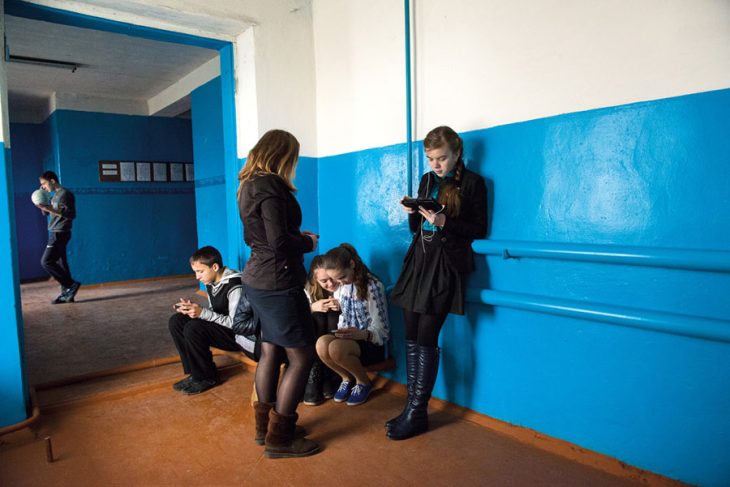
Students during a break. Radinka, 2015 © Pierpaolo Mittica
¿En qué medida tu trabajo sobre Chernóbil ha influido en tus opiniones sobre el futuro de la energía nuclear y los riesgos medioambientales, y cómo intentas reflejar estas preocupaciones en tus imágenes?
Cuando comencé a documentar Chernóbil en 2002, descubrí un mundo detrás de la historia que no solo estaba compuesto por las personas que habían sufrido la catástrofe, sino también por instituciones y agencias internacionales (como la IAEA y la OMS) que durante todos estos años habían intentado minimizar el accidente para proteger los intereses de la industria nuclear civil, en detrimento de las vidas afectadas por el desastre.
Por ello, inicié una investigación sobre la energía nuclear y durante años estudié todo sobre ella desde un punto de vista técnico, político y económico. En todo este tiempo, hablando con científicos involucrados en la energía nuclear, he entendido que la energía de fisión nuclear, la que conocemos hoy, es extremadamente peligrosa debido a los posibles accidentes, altamente contaminante por los desechos que genera y nada económica debido a los altos costes de construcción y desmantelamiento de las plantas. En mis fotografías intento mostrar lo que queda tras un accidente nuclear y todo lo que se pierde: el hogar, la tierra, la vida construida, e incluso nuestras propias vidas y las de nuestros seres queridos.
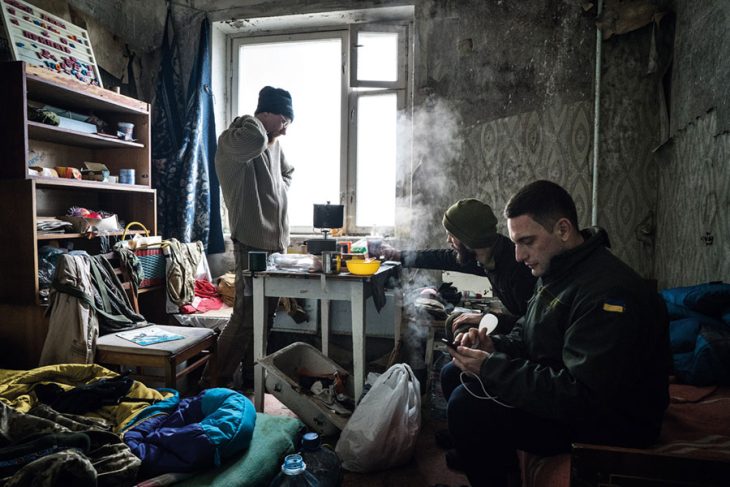
Stalkers Aleksandr Sherekh, Eugene Knyazev and Maxim Rudyavsky preparing breakfast in their apartment. Pripyat, Chernobyl exclusion zone, 2017 © Pierpaolo Mittica
Con el tiempo, la zona de exclusión se ha transformado en un lugar donde naturaleza y radiación coexisten. ¿Cómo has retratado esta transformación a lo largo de tus visitas, y qué impacto visual tiene el contraste entre la regeneración natural y el legado nuclear?
En todos estos años en la zona de exclusión, más de veinte ya, me he dado cuenta de que no estamos destruyendo la naturaleza, sino a nosotros mismos. Al principio quería documentar las consecuencias medioambientales y de salud, que son terribles, pero con el tiempo he visto cómo la naturaleza se adueña de la zona: Prípiat, lentamente engullida por el bosque; los animales regresando a lo que ahora es una reserva natural. Hablando con biólogos locales, entendí que la radiación destruye nuestro ADN y cambia nuestras vidas, pero la naturaleza tiene millones de años para adaptarse. Las plantas sufren mutaciones pero pueden regenerarse. Los animales mutados no sobreviven y no transmiten esas mutaciones. La naturaleza se regula sola porque tiene tiempo, mientras que la humanidad no.
Esta dualidad es la que intento mostrar: una naturaleza que lo reclama todo en un mundo donde los humanos intentan sobrevivir, pero finalmente sucumben.
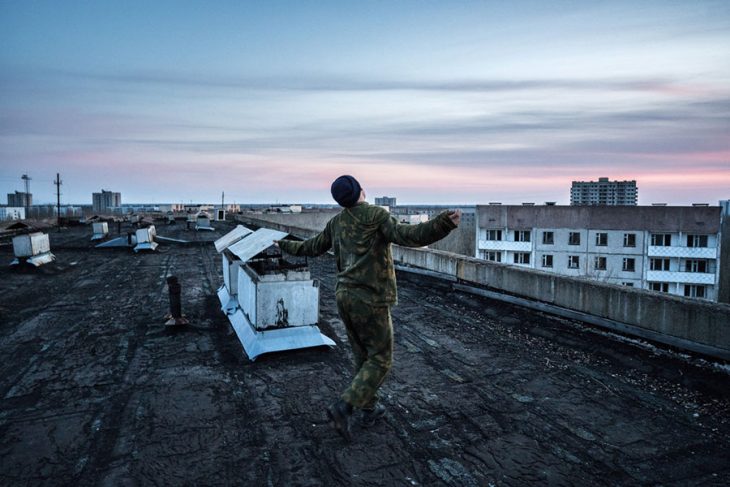
A stalker dancing at sunset on the roof of a building. Pripyat, Chernobyl exclusion zone, 2017 © Pierpaolo Mittica
Durante tus visitas a Chernóbil, has capturado tanto la devastación ambiental como historias individuales. ¿Qué procesos sigues para establecer una conexión emocional con las personas que fotografías, muchas de las cuales han sufrido las consecuencias del desastre durante décadas?
La parte humana en mis historias es predominante y fundamental, porque los desastres ambientales no solo afectan a la naturaleza, sino sobre todo a las personas que viven en ese entorno. Mi proceso para contar historias de personas implica pasar el mayor tiempo posible con ellas para establecer un contacto humano. A menudo paso días enteros simplemente hablando con ellas, escuchando cómo cuentan sus vidas antes de comenzar a fotografiar. Esto me permite establecer una relación de confianza, conocerlas y no ser solo un espectador, sino formar parte de sus vidas y de sus historias. Solo a través de este proceso, dedicando tiempo a estar con ellas, es posible contar una historia en profundidad y con el respeto que estas historias y, especialmente, estas personas merecen.
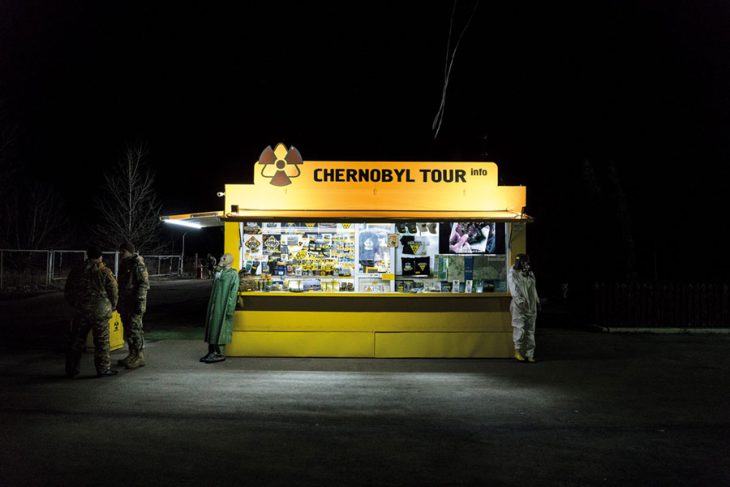
Souvenir shop at the Check Point Dytiatky. Dytiatky, Chernobyl exclusion zone, 2019 © Pierpaolo Mittica
Las imágenes de Chernóbil evocan un sentido de aislamiento y abandono, pero también una especie de extraña belleza postapocalíptica. ¿Cómo trabajas con este dilema estético y ético al intentar capturar la magnitud del desastre sin idealizarlo?
Creo firmemente que la estética en la fotografía es fundamental, no solo para elevar las fotografías a obras de arte, como deberían ser, sino sobre todo porque una foto hermosa siempre impacta al espectador y lo atrae a profundizar en la historia que hay detrás. Para mí, la estética en la fotografía es un medio para llevar la historia a la mayor cantidad de personas posible.
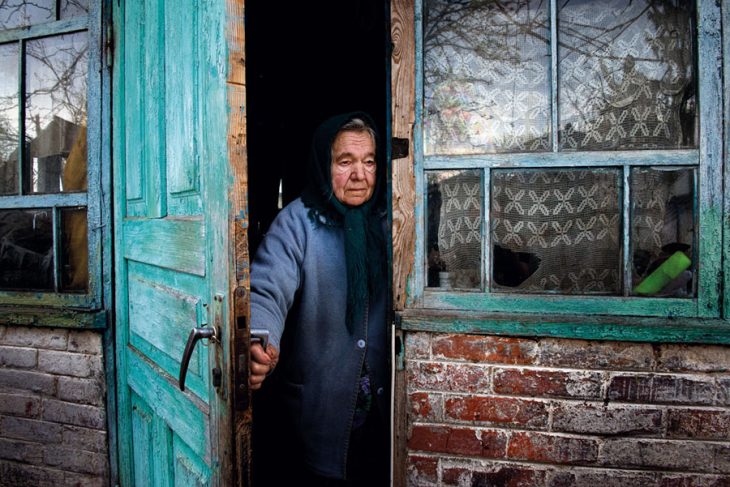
Maria Semenyuk (d. 2016), age 78, in her home. Paryshev, Chernobyl exclusion zone, 2015
© Pierpaolo Mittica
Has dedicado varios años a documentar las secuelas de Chernóbil. ¿Cómo ha evolucionado tu enfoque narrativo y fotográfico con el tiempo, y qué nuevos descubrimientos aún te sorprenden sobre la zona y sus habitantes?
Comencé a documentar Chernóbil en 2002, y desde entonces han pasado 22 años, durante los cuales mi forma de fotografiar y contar historias ha cambiado mucho. Por ejemplo, la primera parte de mi narración sobre Chernóbil, de 2002 a 2007, la realicé en blanco y negro, con película, y estaba enfocada en las consecuencias sanitarias y ambientales de este accidente. Con el tiempo, al pasar mucho tiempo en la zona de exclusión, descubrí historias increíbles de la vida cotidiana, que me fascinaron e impresionaron mucho. Por eso decidí contar todo este mundo de vida en y alrededor de la zona. Paralelamente, mi lenguaje fotográfico también cambió: pasé del blanco y negro al color, y mi forma de fotografiar evolucionó de un lenguaje puramente fotoperiodístico a uno que sigue siendo documental, pero más personal y poético. Este enfoque se refleja en el trabajo que se encuentra en el libro publicado por Gost Books.
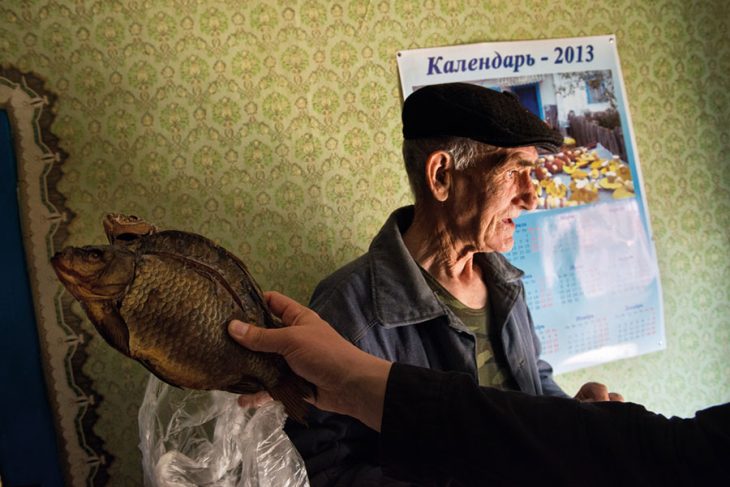
Ivan Ilchinko (d. 2018), age 83, in his home. Kupovate, Chernobyl exclusion zone, 2015 © Pierpaolo Mittica
¿Qué papel crees que puede desempeñar la fotografía documental, como el trabajo que realizaste en Chernóbil, para concienciar al público sobre los riesgos de los desastres nucleares y su impacto duradero en las comunidades y el medio ambiente?
Creo que el trabajo de los fotógrafos es muy importante para dar a conocer ciertos mundos que a menudo son olvidados por el público en general. No soy un utópico; sé que las cosas no siempre cambian a nivel global, pero quizás a nivel local se puede ayudar a muchas personas. En cuanto a la energía nuclear, creo que gracias a mi trabajo y al de muchos fotógrafos y cineastas documentales que han abordado este tema a lo largo de los años, hoy en día la opinión pública está bien informada y, en su mayoría, las personas están en contra de la energía nuclear tal como la conocemos.
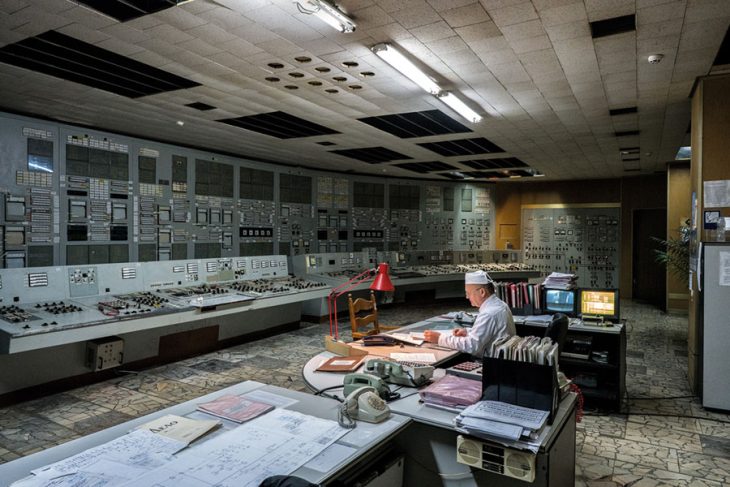
Inside the control room of reactor number 2. Chernobyl nuclear power plant, Chernobyl exclusion zone, 2016 © Pierpaolo Mittica
Al observar tus fotografías de Chernóbil, se percibe una sensación palpable de desolación, pero también un testimonio humano. ¿Qué esperas que las generaciones futuras aprendan de tu trabajo, tanto desde una perspectiva histórica como ética?
Nosotros, los fotógrafos, tratamos de crear obras que puedan informar claramente sobre lo que ocurre en el mundo hoy, pero también de crear memorias históricas para las generaciones futuras. Intentamos construir un archivo histórico que permanezca en la memoria de las personas, porque la memoria es lo más importante para no repetir los errores del pasado. Eso es lo que espero: que gracias al trabajo que hice en Chernóbil y a este libro, las generaciones futuras comprendan el riesgo de la energía nuclear y el legado que les dejamos, y que nunca vuelvan a repetir este gigantesco error que cometimos.
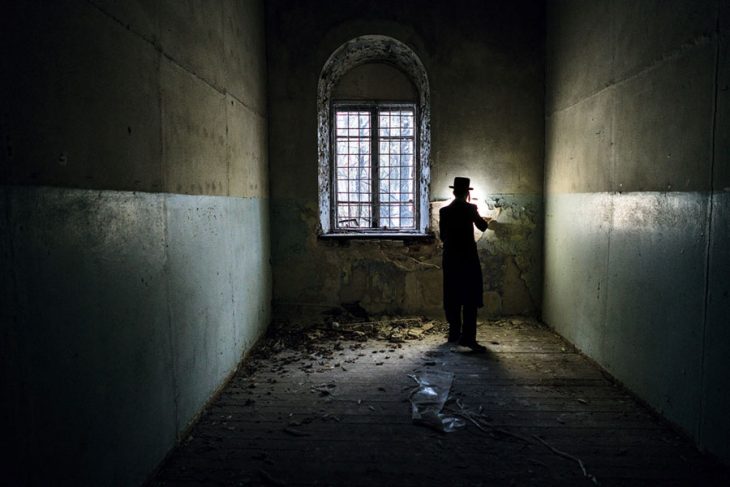
Hasidic Jews inside Chernobyl synagogue. Chernobyl City, Chernobyl exclusion zone, 2016–2017 © Pierpaolo Mittica

The guardian of the city of Pripyat raising the bar to let our van enter. Pripyat, Chernobyl exclusion zone, 2016 © Pierpaolo Mittica
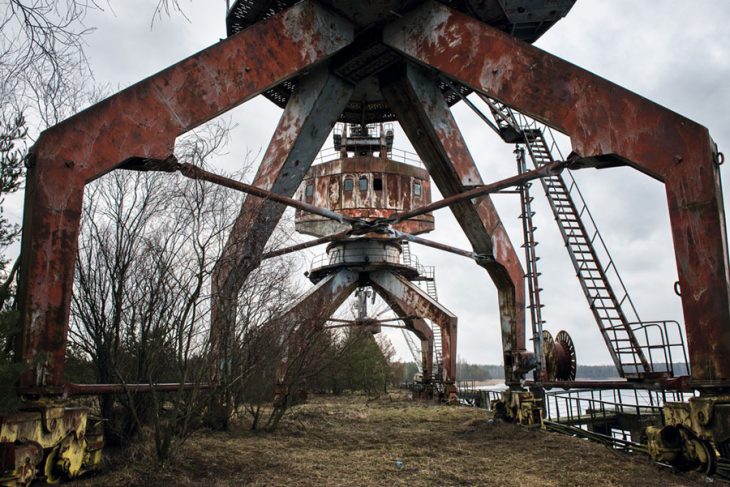
Cranes in the abandoned commercial port, close to the Chernobyl nuclear power plant. Chernobyl exclusion zone, 2016 © Pierpaolo Mittica
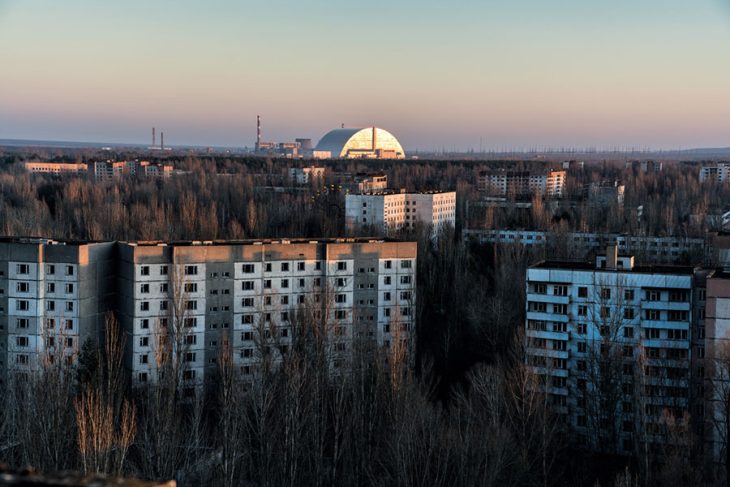
The Chernobyl nuclear power plant as seen from Pripyat. Pripyat, Chernobyl exclusion zone, 2019 © Pierpaolo Mittica
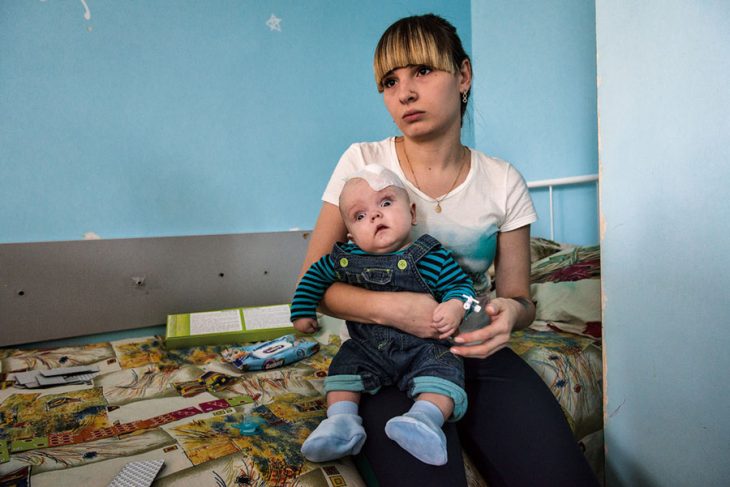
Ania, age 23, with her daughter Roma, age 6 months, suffering from hydrocefalus. Pediatric Clinic of Neurosurgery, Kyiv, 2015 © Pierpaolo Mittica
English:
THE STORIES OF CHERNOBYL.
INTERVIEW WITH PIERPAOLO MITTICA
“Chernobyl” (Gost Books 2024) by Pierpaolo Mittica is a photographic work documenting the consequences of the 1986 Chernobyl nuclear disaster in Ukraine, then part of the Soviet Union. Mittica, an Italian photographer and documentarian, is renowned for his work exploring themes of social and environmental justice. In this book, he delves deeply into the legacy of one of the most severe nuclear disasters in history. Throughout “Chernobyl”, he addresses various aspects: the environmental destruction, the long-lasting effects of radiation on nature and human health, and the resilience of the people who, despite the risks, continue to live in the affected areas, showcasing how life persists amidst desolation.
Pierpaolo Mittica’s work has been acclaimed for his ability to document not only the devastation but also the dignity of those affected by Chernobyl. His photographs bear witness to the long-term consequences of nuclear disasters and serve as a stark warning about the dangers still lurking in places like Chernobyl.
In addition to his photography, Mittica has also created short documentary films and is a committed activist for environmental and humanitarian causes. After discovering and immersing ourselves in his new work, we knew we had to ask him some questions and learn more about Pierpaolo. Here we go!
Your work on Chernobyl goes beyond photography, encompassing a profound social and environmental denunciation. How did you manage to strike a balance between the need to document human tragedy and the devastated environment without exploiting suffering?
for me photography has always been a medium to tell stories, stories of people suffering and enduring immense injustice. but also stories of great humanity and resilience and how people survive in environments devastated by pollution.
I have always believed that photography more than showing must make people think, I have never liked photographs that ‘shout’, photographs that show ‘too much’, on the contrary I believe that a part must not be ‘shown’ directly but left to the imagination of the viewer. one part must be storytelling, one part poetry. Only in this way photographs can strike the imagination of the viewer and involve him emotionally. I also believe that it is essential to always show respect for the subject you are photographing, and this can only be achieved through delicacy, poetry and respect for the subject you are photographing. For me it is a natural process because this is part of my character, my way of being.
When capturing life in the Chernobyl exclusion zone, how did you face the challenge of conveying not only the horror of the catastrophe but also the resilience and humanity of those who continue to live in these areas?
When I started documenting Chernobyl back in 2002, my first project was to tell the story of the health and environmental consequences of this huge catastrophe. In all these years of documenting and being in the exclusion zone, I began to discover an incredible world, an exclusion zone that was not dead but very much alive, made up of people who continued to live and work within the zone, a world of resilience and love for that land lost forever. This fascinated me so much, how human beings manage to go beyond terrible living conditions, out of necessity, out of duty, or simply out of love. And so I started in 2014 the second part of my project on Chernobyl, which was finished in 2019 and published by Gost Books to tell these simple but at the same time extremely complicated stories of life, such as the resettlers, the elderly who wanted to return to live in their homes inside the exclusion zone because the love for that land was too strong.
In addition to very special stories that I was lucky enough to document first, such as the story of the Chernobyl Stalkers, these mostly Ukrainian boys who illegally enter the Chernobyl exclusion zone to make an incredible journey to the ghost town of Pripyat, or the story of the Chassid Jews, Chernobyl before the accident had a very important history because Chassidism, one of the most important currents of the Jewish religion was born in Chernobyl, and every year the Chassid Jews make a pilgrimage to the tombs of the founder of their religion, which is located in Chernobyl city. These are all stories that I have discovered by assiduously frequenting the exclusion zone and thanks above all to my trusted guide Yuriy Tatarchuk, who in all these years of friendship and working together has introduced me to these stories.
The Chernobyl disaster is deeply associated with iconic images of abandonment and desolation. How did you approach creating a visual narrative that offered a new perspective on a topic that has been extensively covered?
When I started documenting Chernobyl in 2002, few Western photographers had chronicled Chernobyl, at that time most likely only Paul Fusco, Gerd Ludwig and a few others. it was a world to be told and that is also why it fascinated me. In recent years, with the opening of the Chernobyl exclusion zone to tourism in 2011, there has of course been a gigantic increase in images of the area, especially of abandoned places that have become tourist attractions, such as the ghost town of Pripyat. But for me, abandoned places had always represented only places where there used to be life, and because of the accident, this life was erased. So in my photos of abandoned places I have always tried to evoke the life that was there before, through very symbolic and evocative photos. I think this is what distinguishes my photos from the millions of images that now exist of the Chernobyl exclusion zone, the constant search for the life that was there before.
To what extent has your work on Chernobyl influenced your views on the future of nuclear energy and environmental risks, and how do you try to reflect those concerns in your images?
When I started reporting on Chernobyl in 2002, I discovered a world behind the story of Chernobyl that was not only made up of the people who had suffered the catastrophe, but also of those people, institutions, and international agencies (IAEA and WHO above all) that over all these years had tried to downplay the accident to protect the interests of the civil nuclear industry, to the detriment of the lives of the people affected by the disaster. So I started an investigation into nuclear power and for years I studied everything about nuclear power from a technical, political and economic point of view.
In all these years of studying and talking with scientists who have always been involved in nuclear power, I have understood that nuclear fission energy, the kind we have today with nuclear power plants, is an extremely dangerous energy, due to the possible accidents that can happen at any time, extremely polluting due to the waste released during the operation of the plant and the waste produced that will remain for hundreds of thousands of years, and an energy that is not at all economical due to the high costs of building the plant and disposing of the plant itself and the waste produced. The interest in civil nuclear power has always been linked to the development of military nuclear power. In my pictures, I try to show what is left after a nuclear accident, an accident that can happen at any time at any nuclear power plant in the world, as Fukushima proved. And all that is lost in a nuclear accident, one’s home, one’s land, everything we have built in life and even our own life or the life of our loved ones, everything we love. With my pictures I try to make this clear, what a huge loss a nuclear accident entails.
Over time, the exclusion zone has transformed into a place where nature and radiation coexist. How have you portrayed this transformation throughout your visits, and what visual impact does the contrast between natural regeneration and the nuclear legacy have?
In all these years that I have been in the exclusion zone, more than twenty years now, I have realised that we are not destroying nature, but ourselves. At the beginning of my work on Chernobyl, I wanted to tell of the health and environmental consequences of the Chernobyl disaster, which are terrible, but in all these years I have seen a rampant nature taking back the exclusion zone, the city of Pripyat slowly being enveloped and submerged by nature, animals gradually returning to the zone that had now become a nature reserve. Talking to local biologists and scientists, I realised that radiation destroys our DNA, changes our lives and future generations, but nature has millions of years before us and millions ahead of us. Plants suffer genetic mutations due to radiation but have a very long life to repair and regenerate. Only the strongest animals survive, the mutated ones die and therefore cannot pass on genetic mutations to future generations as we humans do. Nature regulates itself because it has the time to do so, it is humanity that succumbs. And that is what I try to show in this book, nature taking everything back in a world where humanity tries to survive but eventually succumbs.
During your visits to Chernobyl, you have captured both environmental devastation and individual stories. What processes do you follow to establish an emotional connection with the people you photographed, many of whom have suffered the consequences of the disaster for decades?
The human part in my stories is predominant and fundamental because environmental disasters not only involve nature but above all the people who live in that environment. My process for telling people’s stories is to spend as much time as possible with them in order to establish a human contact with them. I often spend whole days simply talking and having them tell me about their lives before I start photographing. This allows me to establish a relationship of trust with people and get to know them. And it allows me to not just be a spectator, but to be part of their lives and their stories. Only through this process, by spending a lot of time with them, is it possible to tell a story in depth and with the due respect that these stories and especially these people deserve.
The images of Chernobyl evoke a sense of isolation and abandonment, but also a kind of strange post-apocalyptic beauty. How do you work with this aesthetic and ethical dilemma when trying to capture the magnitude of the disaster without idealizing it?
I strongly believe that aesthetics in photography is fundamental, to elevate photographs to works of art, as they should be, but above all because a beautiful photo always strikes the viewer, and then attracts him to delve deeper into the story behind it. So for me, aesthetics in photography is a medium of getting the story to as many people as possible.
You have dedicated several years to documenting the aftermath of Chernobyl. How has your narrative and photographic approach evolved over time, and what new discoveries have you made that still surprise you about the zone and its inhabitants?
I started reporting on Chernobyl in 2002 and since then of course 22 years have passed and a lot has changed in the way I photograph and tell stories. For example, the first part of my Chernobyl storytelling, which was from 2002 to 2007, was done in black and white, on film, and focused on the health and environmental consequences of this accident. In the meantime, as I spent a lot of time in the Chernobyl exclusion zone, I discovered incredible stories of everyday life, which fascinated and impressed me a lot, so I decided to tell this whole world of life in and around the zone. In the meantime, over the years, my photographic language has also changed and I have moved from black and white to colour, and my way of photographing has also changed, moving from a purely photojournalistic language to one that is still photojournalistic, but more personal and poetic. And it is the work that can be found in the book published by Gost Books.
What role do you believe documentary photography, like the work you did in Chernobyl, can play in raising public awareness about the risks of nuclear disasters and their lasting impact on communities and the environment?
I believe that the work of us photographers is very important to bring knowledge of certain worlds that are often forgotten to the general public, but I am not a utopian, I know that things often don’t change on a global level, but maybe on a local level you can help a lot of people. In any case, as far as nuclear power is concerned, I believe that thanks to my work and the work of many photographers and documentary filmmakers who have dealt with nuclear power over all these years, today public opinion is well informed and for the most part people are rightly against nuclear power as we know it today.
Looking at your photographs of Chernobyl, there is a palpable sense of desolation but also human testimony. What do you hope future generations will learn from your work, both from a historical and ethical standpoint?
we photographers try to create works that can clearly inform about things happening in the world today but also create historical memories for future generations. We try to create a historical archive that can remain in people’s memories because memory is the most important thing in order not to repeat mistakes. And that’s what I hope: thanks to the work I did on Chernobyl and thanks to this book, I hope that future generations will understand the risk of nuclear power and the legacy we left them, and will never again repeat this gigantic mistake we made.